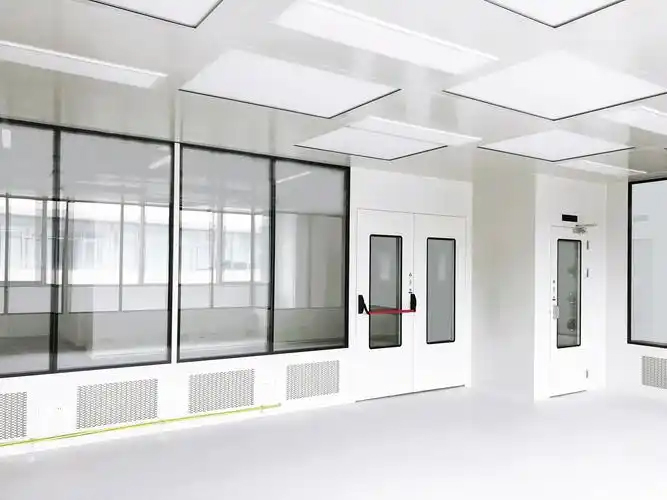Designing a Hardwall Cleanroom
A Comprehensive Guide to Creating Controlled Environments
Introduction to Cleanroom design
Creating a hardwall cleanroom requires meticulous planning and execution to meet specific cleanliness requirements. Whether for research, pharmaceutical, or industrial applications, the design process demands a thorough understanding of standards and a keen eye for detail. This guide outlines the steps involved in designing a hardwall cleanroom, focusing on critical factors such as air filtration, environmental control, and structural integration.
Research Applications
Precision environments for sensitive experiments and development work.
Pharmaceutical
Sterile environments for drug manufacturing and medical device production.
Electronics
Contamination-free spaces for semiconductor manufacturing.
Determining Cleanroom Class and Requirements
Before beginning the design, determine the necessary cleanliness level based on the ISO 14644-1 classification system.
This involves identifying the types and sizes of particles you need to control. Consider environmental factors such as temperature and humidity which can affect both the process and the particle count within the cleanroom. For instance, a pharmaceutical application may require an ISO Class 5 Cleanroom to ensure critical sterility throughout production.
ISO Classification System
ISO classifications range from ISO 1 (most clean) to ISO 9 (least clean). The classification is determined by the maximum allowable concentration of airborne particles per cubic meter.
ISO Cleanroom Standards
| ISO Class | Particles ≥0.1µm | Typical Applications |
|---|---|---|
| ISO 1 | 10 | Semiconductor manufacturing |
| ISO 3 | 1,000 | Pharmaceutical sterile filling |
| ISO 5 | 100,000 | Hospital pharmacies, medical devices |
| ISO 7 | 1,000,000 | Automotive painting, food processing |
Critical Design Factors
Room Location and Size
Selecting an appropriate location within your facility is pivotal. Ensure that the space is large enough to accommodate all personnel, equipment, and necessary operations. hardwall Cleanrooms can be either freestanding constructions or integrated into existing structures.
Wall and Ceiling Structures
Choose materials for the Cleanroom walls that are non-shedding, durable, and easy to clean, such as coated steel or aluminum panels. Ceilings should support the necessary filtration units and lighting.
Temperature and Humidity
Regulate temperature and humidity levels in line with process requirements. Utilize an HVAC system to maintain these levels consistently, preventing conditions that could lead to condensation or microbial growth.
Airflow Management
HEPA filters are essential for removing airborne particles within a cleanroom. Determining the required air changes per hour (ACH) is crucial. For example, an ISO Class 5 Cleanroom typically requires 240-480 air changes per hour.
A design that incorporates a unidirectional airflow pattern helps direct contaminants away from critical areas, essential for maintaining a contamination-free environment.
Positive pressure differential is fundamental to preventing contaminants from entering the cleanroom. This involves careful planning and calculation to ensure consistent pressure levels.
Consider how the cleanroom interfaces with adjacent spaces to prevent unwanted air exchange, a critical factor in contamination control.
Lighting and Auxiliary Factors
Adequate lighting is vital for operational accuracy and safety. Plan for areas dedicated to gowning and de-gowning, crucial for minimizing contamination risk. Providing training for personnel on proper cleanroom procedures helps maintain compliance and efficiency.
Infrastructure Integration
System Integration
Hardwall cleanrooms can often leverage existing building HVAC systems to reduce costs, provided that the systems meet necessary specifications. Consider how to integrate with current utilities and equipment to maintain seamless operations and reduce operational disruptions during installation.
- Assess compatibility of existing HVAC systems
- Plan utility connections (electrical, water, gas)
- Coordinate with building management systems
- Ensure proper interface with adjacent spaces
Implementation Process
Successful cleanroom implementation follows a structured approach:
- Needs Assessment: Define requirements and specifications
- Conceptual Design: Develop initial layout and flow diagrams
- Detailed Design: Create technical specifications and drawings
- Installation: Execute construction with minimal disruption
- Certification: Validate performance against standards
Flexible Dimensions
Customizable to fit any facility layout
Energy Efficient
Optimized systems reduce operational costs
Modular Design
Easy expansion or reconfiguration
Compliance Ready
Meets all regulatory requirements
Frequently Asked Questions
Why is positive pressure important in cleanrooms?
Positive pressure prevents external contaminants from entering the cleanroom, maintaining the required cleanliness level. It ensures air flows out of the cleanroom rather than unfiltered air flowing in.
How do HEPA filters function in a cleanroom?
HEPA filters remove 99.97% of airborne particles ≥0.3 µm, which is crucial for maintaining cleanroom standards. They work by forcing air through a fine mesh that traps harmful particles.
What is the typical lifespan of a cleanroom?
With proper maintenance, a well-designed hardwall cleanroom can last 15-20 years. Regular filter replacement and surface maintenance are essential for longevity.
How often should cleanrooms be certified?
Initial certification occurs after installation, with subsequent certifications typically performed annually. More critical applications may require semi-annual or quarterly testing.
Conclusion
In summary, designing a hardwall cleanroom is a detailed process that requires careful consideration of various factors, from air filtration and pressure control to structural integration and environmental regulation. By employing strategic design principles and adhering to international standards, companies can deliver solutions that meet stringent requirements while offering flexibility and cost-effectiveness.
References
- International Organization for Standardization. (2015). iso 14644-1: Cleanrooms and associated controlled environments.
- US Pharmacopeia. (2018). USP 797.
- Deiiang™, Official Guidelines on Cleanroom Design.
- Federal Standard 209E (1992) for Cleanroom Standards.
- The University of Michigan, Cleanroom Design Guidelines.
 +86 18186671616
+86 18186671616 Jason@cleanroomequips.com
Jason@cleanroomequips.com
 MENU
MENU




